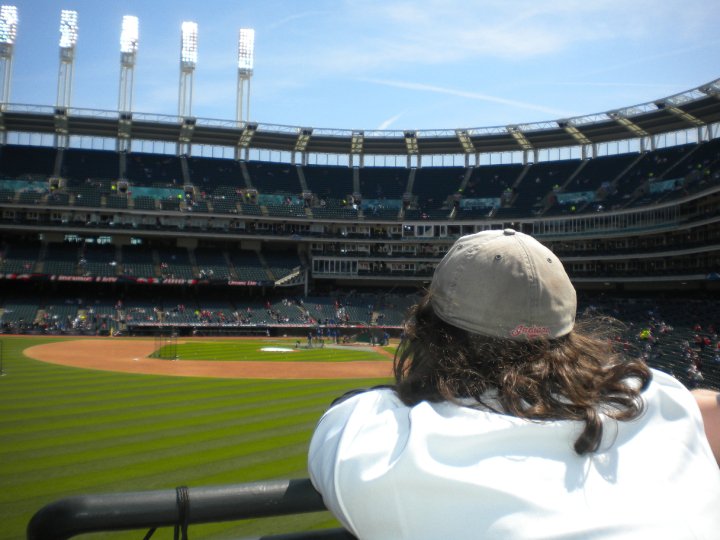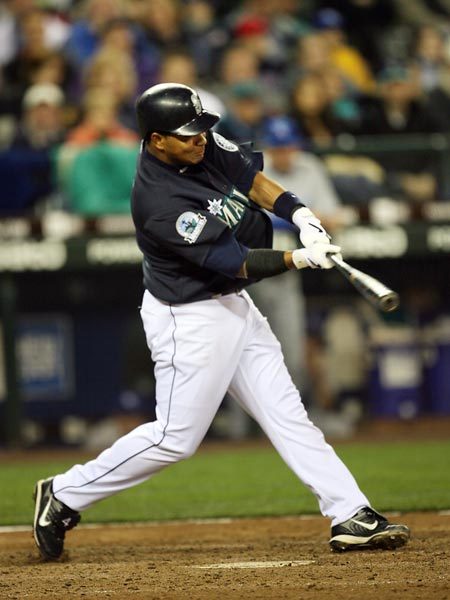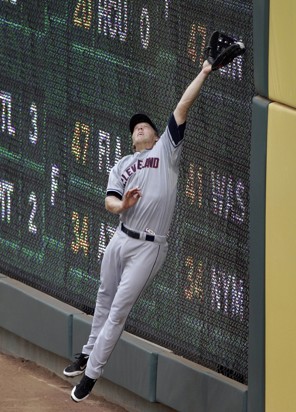 Indians Archive
Indians Archive  View from the Porch: Spring Training Observations
View from the Porch: Spring Training Observations
 Spring Training is a little more than halfway done as we finally get under the 20-day mark until Opening Day. Starting pitchers are being extended to four innings per start and some hitters are getting three or four plate appearances per game. Things like this are all a part of the preseason process. While statistics, wins, and losses are calculated for posterity sake, they really hold little importance during Cactus League play.
Spring Training is a little more than halfway done as we finally get under the 20-day mark until Opening Day. Starting pitchers are being extended to four innings per start and some hitters are getting three or four plate appearances per game. Things like this are all a part of the preseason process. While statistics, wins, and losses are calculated for posterity sake, they really hold little importance during Cactus League play.
That being said, there are plenty of important developments going on. Thanks to MLB Network and Sportstime Ohio, I’ve had the pleasure of watching more Spring Training baseball than I have in the past and it’s really given me a lot of perspective thus far. A lot of people discredit Spring Training baseball as nothing more than stretching out the starting pitchers and allowing hitters to get their timing back. But, there’s more to Spring than meets the eye.
In this week’s View from the Porch, I’ll examine and analyze what I’ve seen so far, what I want to see continue and some things to watch for as the Indians move closer and closer to the start of the 2012 MLB Regular Season.
 So far, the biggest thing I’ve seen is a major concern. Ubaldo Jimenez. I don’t necessarily care about his 6 ERA because he has been the victim of a lot of bad luck. He’s been susceptible to infield hits, bloopers, and defensive miscues in each of his starts. None of those things are his fault.
So far, the biggest thing I’ve seen is a major concern. Ubaldo Jimenez. I don’t necessarily care about his 6 ERA because he has been the victim of a lot of bad luck. He’s been susceptible to infield hits, bloopers, and defensive miscues in each of his starts. None of those things are his fault.
What is Ubaldo’s fault, however, is that he has had plenty of trouble repeating his mechanics. Jimenez has walked five batters and only struck out two in his six innings of Spring work. In the games I could find pitch counts for, Jimenez has thrown 94 pitches and 58 for strikes. In the Anaheim start I can’t find a pitch count for, Jimenez had a 31-pitch first inning. This continues a trend of Jimenez’s dating back to the 2006 season. In 28 Spring appearances, Jimenez has struck out 63 and walked 54.
He has a bit of an unconventional delivery with his wiry 6’5” frame. At the tail end of his windup, he brings the ball fully behind his back and then catapults it at an overhand arm slot. Repeating this delivery is a difficult thing to do because the motion that Jimenez uses requires him to hold the ball a long distance and then release it at the apex of his forward motion. If the position of his hand is too far left or right, or he releases too early or too late, he will lose his command. He also closes his non-throwing shoulder to the hitter, throwing another wrench into his windup.
For those who are more visual minded, here is a video of Jimenez’s delivery.
By comparison, watch Josh Tomlin’s delivery. You’ll notice that Tomlin has a more compact delivery and throws from more of a three-quarter arm slot. Tomlin has a reputation as a strike-thrower. His delivery is easier to repeat and has a quicker path to release. Tomlin stays open toward the hitter.
Generally, a simple, fluid delivery like Tomlin’s would give him more margin for error than somebody like Jimenez.
 When Jimenez is getting on top of his sinker and throwing it on a downward plane, he can be very tough to hit. But, what I’ve seen this Spring is that Jimenez is staying underneath the sinker and leaving pitches up in the zone or getting too on top of his sinker and putting it into the ground. The number of soft hits and bloopers means that his ball is moving and that his velocity is good, but he’s also getting into too many hitters’ counts and eliminating the chance of striking a hitter out.
When Jimenez is getting on top of his sinker and throwing it on a downward plane, he can be very tough to hit. But, what I’ve seen this Spring is that Jimenez is staying underneath the sinker and leaving pitches up in the zone or getting too on top of his sinker and putting it into the ground. The number of soft hits and bloopers means that his ball is moving and that his velocity is good, but he’s also getting into too many hitters’ counts and eliminating the chance of striking a hitter out.
And this is just fastball command. He’s thrown very few breaking balls. That’s really scary. Everything works off a pitcher’s fastball. Hitters don’t have to swing at breaking balls if a pitcher can’t spot the fastball. When ahead in the count last season, hitters hit .345 off Jimenez. When Jimenez was ahead in the count, they hit .178. With an even count, hitters batted .235. Obviously, he needs to pitch from ahead.
Jimenez is a big key to the Indians success or failure this season. One thing that detractors tried to use to validate their concerns with the Jimenez trade was exactly what we’re seeing – inconsistent mechanics. Last year, the front office chalked it up to injuries that Jimenez suffered in Spring Training and never fully recovered from during the season. Unless these command and mechanic issues are fixed, Jimenez will be a “boom or bust” kind of guy this season.
Many people like to believe that sinkerballers get better as the season progresses because a sinker has more movement when some of the velocity is taken off of it. As arm fatigue begins to build, the sinker becomes a more effective pitch. Perhaps this is true of Jimenez thus far. But, from the eye test I’ve given him, I would chalk it up more to being unable to repeat his mechanics. The stats over a sample size of 95 innings prove that Jimenez has trouble getting into a rhythm in the Spring.
Spring Training should be like opening a Playboy or Penthouse (or Playgirl, for the ladies) for those who believe more in the eye test than the number-based approach to player evaluation. I like to use both to prove a point and evaluate a player. During Spring Training, however, using numbers is very difficult to do and the eye test is a better gauge for performance analysis.
 Take Jose Lopez and Russ Canzler for example. Jose Lopez is straight tearing the cover off the ball. Entering Saturday’s game, Lopez is hitting .529/.600/1.000/1.600 over 17 at bats. We all know that isn’t going to carry over to the 162-game schedule. Also, unless you’ve charted every at bat, you have no idea what pitchers Lopez is doing this off of. The Indians probably do, but who knows how much they care?
Take Jose Lopez and Russ Canzler for example. Jose Lopez is straight tearing the cover off the ball. Entering Saturday’s game, Lopez is hitting .529/.600/1.000/1.600 over 17 at bats. We all know that isn’t going to carry over to the 162-game schedule. Also, unless you’ve charted every at bat, you have no idea what pitchers Lopez is doing this off of. The Indians probably do, but who knows how much they care?
Russ Canzler is hitting .400/.444/.440/.884 so far over 25 at bats, which is tied for the team lead in that category. This is Canzler’s first extended look in his career during Spring Training as he had just 18 ABs in his previous three years.
What the Indians care about is what I care about – quality plate appearances. Not many guys stand there and work counts in Spring Training, so that’s not the only way to evaluate a PA. It’s about selecting the pitch to hit and hitting it hard. I’m sure you’ve heard a broadcaster talk about “hitting it where it’s pitched”. That’s a pretty simple concept. If it’s a pitch on the outside half of the plate, hitting it where it’s pitched would be hitting it to that side of the field.
That’s what Lopez and Canzler have done so far. Lopez has used the entire ballpark while accumulating his impressive totals. Canzler has repeatedly hit line drives back up the middle and hammered mistakes through the hole between shortshop and third base. No matter what caliber of pitching they have faced, the mechanics of hitting remain the same. Staying on the baseball and keeping the swing level. Dropping the bat head to get the barrel on the ball and square it up rather than top it and pound it into the ground. Pitch selection. Plate discipline.
Whether a hitter is facing Justin Verlander or Joe Double-A, the chances of getting a hit are increased by good habits in the batter’s box. If these start in Spring, they will be more prevalent during the season. Consider how easy it is to get pull happy and homer happy with the tremendous hitting conditions in Arizona. Then consider how pissed off you get when Carlos Santana is obviously trying to hit home runs. Then consider how excited you get when Santana hits a double to right center off a tough lefty.
The best compliment you can pay a hitter is “that was a good piece of hitting”. That’s a really loaded expression. It could mean any number of good things. It could mean that the hitter went up there with a gameplan and stuck to it. It could mean that he fought off a couple of pitches before lacing a single to right field. It could mean that he crushed a hanging slider to the bleachers. It could mean that he did his job, whether that was advance a runner to third with nobody out or lift a sac fly to medium-deep left field to drive in the runner from third.
Players who are in position battles in Spring have no control over whether a line drive drops or is tracked down by an outfielder. They can’t dictate whether a deep fly ball that drives in a run falls into the outfielder’s glove or has enough juice to go over the fence. They can, however, control whether they pull an outside fastball weakly to third or chase a slider in the dirt. Roster spots are won by doing the little things in Spring Training.
 Take a look at the Indians’ left field/bench situation. Shelley Duncan is all but guaranteed an Opening Day spot. Russ Canzler, Jose Lopez, Ryan Spilborghs, and Aaron Cunningham are all vying for one other spot. Lopez, with his inability to play the outfield, really has to shine in order to make the team. With three or four guys all trying to grab a uniform on April 5, there are only so many Spring at bats to go around. Average hitters will fail 73-75% of the time, if not more. That doesn’t stop a hitter from having a quality at bat. Quality at bats do not necessarily have to end in hits or walks. With limited exposure, and managers worrying about other things at the same time, those four guys have had a lot of good plate appearances and that’s all you can ask for with a competition like that.
Take a look at the Indians’ left field/bench situation. Shelley Duncan is all but guaranteed an Opening Day spot. Russ Canzler, Jose Lopez, Ryan Spilborghs, and Aaron Cunningham are all vying for one other spot. Lopez, with his inability to play the outfield, really has to shine in order to make the team. With three or four guys all trying to grab a uniform on April 5, there are only so many Spring at bats to go around. Average hitters will fail 73-75% of the time, if not more. That doesn’t stop a hitter from having a quality at bat. Quality at bats do not necessarily have to end in hits or walks. With limited exposure, and managers worrying about other things at the same time, those four guys have had a lot of good plate appearances and that’s all you can ask for with a competition like that.
Extending the quality plate appearance point to the Lonnie Chisenhall/Jack Hannahan position battle, Chisenhall has struck out 10 times in 21 trips to the plate. Hannahan is only hitting .222, but has a grand slam to his name. I am on record as saying that Chisenhall has to win the job over Hannahan and it seems like Manny Acta agrees. Chisenhall has not shown the adjustments he needed to make in plate discipline or pitch selection. I would imagine that Chisenhall is playing a little tight right now knowing that he has to have a pretty good Spring to get the starting gig, especially because Jose Lopez is showing himself to be a viable utility infielder candidate and Jason Donald will already be on the roster. Even though The Chiz Kid is the future at 3B, it’s hard to envision him breaking camp with the team.
So, to finish things up, what should we keep looking for as Spring Training winds down? Well, first and foremost, we have to keep watching Ubaldo Jimenez. There’s no doubt that he has some issues. He’s healthy, so that’s the silver lining. The problems he has are correctable because they’re pitching mechanics and not injuries. As he gets extended to five and six innings, it will be easier to make in-game adjustments and have more film to watch. I think he needs a couple good outings to build some confidence entering the season.
Another thing to keep an eye on is Rafael Perez’s shoulder trouble. R. Perez has yet to appear in a Spring Training game and that’s big. Tony Sipp has periods of dominance flanked by periods of atrociousness. The Indians really need a reliable southpaw like Raffy. For him to have not yet pitched as of March 17, that’s a glaring problem.
Along the same lines, Casey Kotchman is still dealing with a back issue. Health is what will keep the Indians in the AL Central race this year, so there’s no reason to rush Kotchman back. Let’s just hope it’s not a recurring issue that he’ll have to play through all year.
Finally, I’m curious to see the construction of Manny Acta’s lineup, something I’ll touch on in one of my VftP articles prior to Opening Day. Jason Kipnis has already hit sixth a couple of times. Jason Donald has been batting ninth. As the starters start to play more, Acta will probably try to get them comfortable with their spot in the batting order.
Let’s just get through the rest of Spring Training healthy and with as many of the issues resolved as possible.
- NBA Announces 2013-2014 Schedule
- Browns Ink Sharknado
- Sharknado A No-Show For Rookie Camp
- Trent Richardson Out Until Training Camp
- Browns Sign Brandon Jackson
- Carrasco Suspended Eight Games
- Browns Add to Wide Receiver Depth with David Nelson
- Browns Need to Learn from Past Draft Mistakes
- Browns Release Chris Gocong and Usama Young
- Browns Missing on Grimes Disappointing, But Not The End
The TCF Forums
- Chris Grant's first 3 drafts
Kingpin74 (Tuesday, January 21 2014 10:13 AM) - The 2014 Offseason Thread
googleeph2 (Tuesday, January 21 2014 9:36 AM) - 2015 Recruiting
furls (Tuesday, January 21 2014 6:57 AM) - Mike Brown
YahooFanChicago (Monday, January 20 2014 11:15 PM) - Movies coming out
HoodooMan (Monday, January 20 2014 9:34 PM) - 2014 Hoops Hockey Hijinx
jpd1224 (Monday, January 20 2014 4:44 PM) - 2014 Recruiting
jclvd_23 (Monday, January 20 2014 2:26 PM) - Wish List - #4 Pick
Hikohadon (Monday, January 20 2014 1:26 PM) - Official- Browns Coach Search/Rumors
OldDawg (Sunday, January 19 2014 6:48 PM) - #1 overall pick Anthony Bennett
TouchEmAllTime (Sunday, January 19 2014 1:28 PM)



